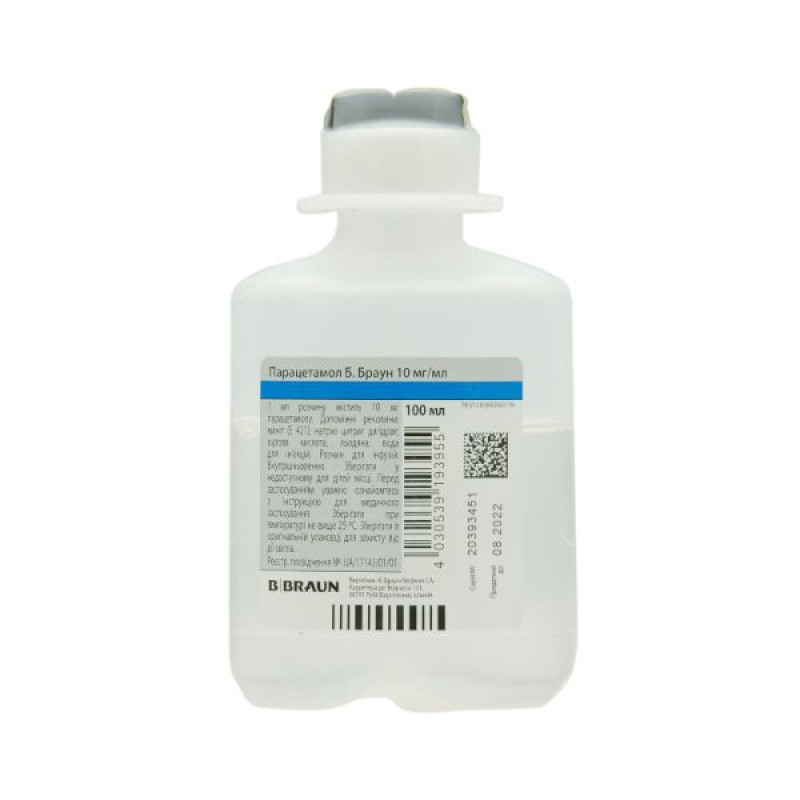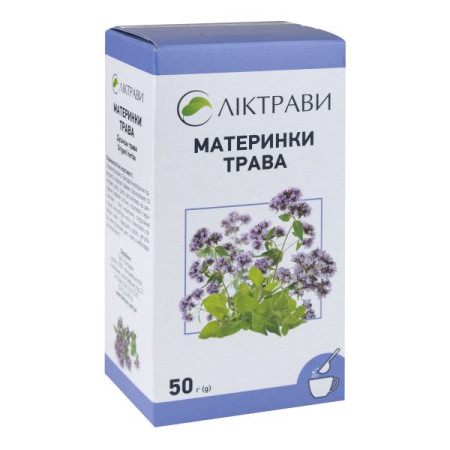Paracetamol B. Brown 1% solution for infusions 10 mg/ml bottle 100 ml No. 10

Infusion solution "Paracetamol B. Braun 10 mg/ml" is used for the following indications:
Short-term treatment of moderate pain, especially after surgery; Short-term treatment of fever; For intravenous administration when clinically justified by the urgent need for treatment of pain or hyperthermia and/or when other routes of administration are unavailable.Composition
The active substance is paracetamol (1 ml of solution contains 10 mg of paracetamol).
Excipients: mannitol (E 421); sodium citrate dihydrate; acetic acid, glacial; water for injections.
Contraindication
Hypersensitivity to paracetamol, propacetamol hydrochloride (precursor to paracetamol) or to any of the excipients.
Cases of severe liver failure.
Method of application
The 100 ml bottle is intended only for adults, adolescents and children weighing more than 33 kg.
Dosage
The dose to be administered and the size of the container to be used depend solely on the patient's body weight. The volume to be administered should not exceed a certain dose. If necessary, the required volume should be diluted in a suitable infusion solution before administration or a syringe pump should be used.
"Paracetamol B. Braun 10 mg/ml" can be used undiluted and, if necessary, diluted in 9 mg/ml (0.9%) sodium chloride solution for infusion or 50 mg/ml (5%) glucose solution for infusion, or a combination of both solutions to one tenth of the drug.
Dosage depending on the patient's body weight.
Method of use
For intravenous use.
The paracetamol solution is administered as a 15-minute infusion.
Patients with body weight ≤ 10 kg.
The volume to be administered should be removed from the container and diluted in sodium chloride solution 9 mg/ml (0.9%), or in glucose solution 50 mg/ml (5%), or in a combination of both solutions to 1/10 of paracetamol (one tenth of the volume of the "Paracetamol B. Braun 10 mg/ml" solution 10 mg/ml in nine tenths of the solvent) and administered within 15 minutes.
A 5 ml or 10 ml syringe should be used to measure the dose according to the child's weight and the desired volume. However, never exceed 7.5 ml per dose.
To comply with the dosage, the user should consult the drug information.
"Paracetamol B. Braun 10 mg/ml" can be diluted with sodium chloride solution 9 mg/ml (0.9%) or glucose solution 50 mg/ml (5%), in a combination of both solutions to 1/10 of paracetamol (one tenth of the volume of the "Paracetamol B. Braun 10 mg/ml" solution in nine tenths of the solvent). In this case, the diluted solution must be used within 1 hour after preparation, including the time for infusion.
For single use only. Any unused solution should be discarded.
Before administration, the drug should be visually inspected for any particulate matter and discoloration. Use only if the solution is clear, colorless or slightly pinkish-orange (perception of color may vary) and the container and its cap are undamaged.
As with any injectable solution supplied in air-entrained containers, it is important to remember that the infusion of the solution, regardless of the route of administration, should be carefully monitored, and special attention should be paid at the end of the infusion. This attention at the end of the infusion is particularly relevant for central venous infusions to avoid air embolism.
An introductory part of the instructions is provided, read the full instructions inside the package.
Application features
Pregnant women
"Paracetamol B. Braun 10 mg/ml" should be used during pregnancy only after a careful assessment of the benefit-risk ratio. In this case, the recommended dose and duration of treatment should be strictly adhered to.
After oral administration, paracetamol passes into breast milk in small amounts. No side effects have been reported for newborns. "Paracetamol B. Braun 10 mg/ml" can be used by women who are breastfeeding.
Children
The 100 ml bottle is intended only for children weighing more than 33 kg.
Drivers
There is no significant effect on the reaction speed when driving vehicles or other mechanisms.
Overdose
Symptoms
There is a risk of liver damage (including fulminant hepatitis, hepatic failure, cholestatic hepatitis, cytolytic hepatitis), especially in the elderly, young children, patients with liver disease, in cases of chronic alcoholism, in patients with chronic malnutrition and in patients receiving enzyme inducers. Overdose can be fatal in these cases.
Symptoms usually appear within the first 24 hours and include: nausea, vomiting, anorexia, pallor and abdominal pain. Immediate action should be taken in the event of a paracetamol overdose, even if symptoms are absent.
Overdose of 7.5 g or more of paracetamol in a single dose in adults or 140 mg/kg body weight in a single dose in children causes liver cytolysis, which can lead to complete and irreversible necrosis, causes hepatocellular failure, metabolic acidosis and encephalopathy, which can lead to coma and death. At the same time, there is an increase in the level of liver transaminases (AST, ALT), lactate dehydrogenase and bilirubin, together with a decrease in the level of prothrombin, which may appear 12-48 hours after administration. Clinical symptoms of liver damage, as a rule, first appear after two days and reach a maximum after 4-6 days.
Treatment
Immediate hospitalization.
Before starting treatment and as soon as possible after an overdose, take a blood sample for analysis of paracetamol in the blood plasma.
Treatment involves administering the antidote N-acetylcysteine (NAC) intravenously or orally, if possible, before 10 hours after overdose. However, NAC may provide some protection even after 10 hours, but in these cases, long-term NAC treatment should be considered.
Symptomatic treatment
Liver function tests should be performed at the start of treatment and repeated every 24 hours. In most cases, hepatic transaminases return to normal within 1-2 weeks with full recovery of normal liver function. However, in very severe cases, liver transplantation may be necessary.
Side effects
As with all paracetamol products, adverse reactions to the drug are rare.
Storage conditions
Store in the original packaging to protect from light at a temperature not exceeding 25 °C, out of the reach of children.
Expiration date:
closed container - 2 years; after opening - infusion should be started immediately after connecting the container to the infusion system; after dilution - chemical and physical in-use stability (including administration time) of the solutions was maintained for 48 hours at 23 °C.To avoid microbiological contamination, the product should be used immediately.
There are no reviews for this product.
There are no reviews for this product, be the first to leave your review.
No questions about this product, be the first and ask your question.










